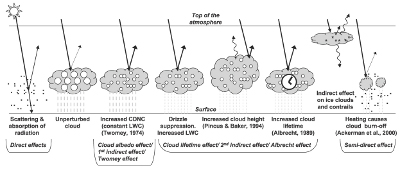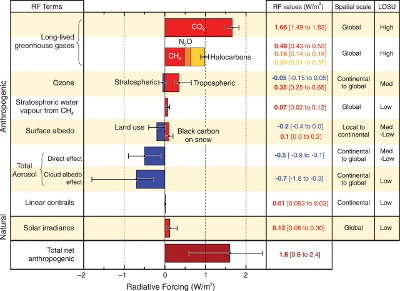SDS & climate system
Impact on climate and weather
Aerosols influence the climate and weather in two ways: through aerosol direct effects and aerosol indirect effects. Dust is recognized as a major component of atmospheric aerosol that is an essential climate variable [1].
The direct effect refers to scattering and absorption of radiation by aerosols influencing the radiative balance of the Earth-atmosphere system. The indirect effect refers to changing radiative properties, amount and lifetime of clouds by microphysical processes due to the aerosols and hence changing the cloud albedo and the Earth’s radiation budget.

Aerosol direct and indirect effects; IPCC Fourth Assessment Report (2007), Fig. 2.10
The contributions of aerosols to radiative forcing are quite uncertain but mostly estimated to be negative. However, in regions with high anthropogenic aerosol concentrations, aerosol forcing may be of the same magnitude as the effect of all greenhouse gases, but of opposite sign.

Radiative forcing; IPCC Fourth Assessment Report (2007), Fig. SPM.2
Direct effect
There are three processes causing the direct aerosol effect:
- the absorption of the longwave radiation and incoming solar radiation [2]
- the longwave radiation emitted by the Earth surface is backscattered by the mineral dust particles [3]
- incoming shortwave radiation is backscattered as well (global dimming) [4] .
All three processes result in reductions of the surface temperature (surface cooling) [2, 4], which leads to a decrease of the net surface radiation forcing of about 1 Wm-2, at the same time with a increase in lower atmospheric heating of about 1 K day-1 due to absorption [2, 5, 6]. The change of the atmospheric heating may be a significant forcing of atmospheric dynamics [5], for example the convective activity and that way the convective available potential energy (CAPE) is reduced [4]. Perturbations in the regional and global climate might be a consequence [2].
The interaction of the dust particles with radiation depends on the properties of the dust particles. The size distribution of the mineral aerosols influences strongly the radiative forcing [7]. For instance especially large dust particles interact with thermal radiation [8]. In addition to that, the albedo of the dust particles is dependent on their composition/mineralogy [9].
Indirect effects
Clouds are affected by aerosols, amongst others mineral dust [10]. By changing the properties of clouds aerosols have an indirect forcing on two components: the radiative balance and precipitation [11]. The indirect effect corresponding to radiative forcing is called cloud albedo effect or Twomey effect, the one corresponding to the hydrological cycle is called cloud lifetime effect [12, 13]. Model simulations show that both effects have a similar magnitude [12].
How do the dust particles change the properties of the clouds?
Dust particles often act as cloud condensation nuclei (CCN), which means they are nuclei for the condensating water vapour. When a cloud comes into contact with mineral dust, the number of CCN increases, so that the number of cloud droplets also increases. With the same amount of liquid water, the size of each droplet decreases (water is distributed among more CCN) [14]. A “contaminated” cloud has more numerous but smaller cloud droplets as a “clean” cloud, which leads to different properties.
One difference is the radiative properties (cloud albedo effect): the reflectivity/the optical depth of the contaminated cloud is enhanced [15]- the cloud is brighter, which causes an increased albedo [14]. This means that more radiation is backscattered into the space, so that the net solar radiation at the top-of-the atmosphere is reduced [13] and it gets cooler.
The other difference is the production of precipitation. Small droplets are growing less probable by coalescence than bigger ones [16], so that precipitation could be diminished or suppressed depending on environmental conditions, cloud types and the stage in the storm’s lifecycle [10, 17]. By diminishing or suppressing rainfall the lifetime of the cloud changes, it takes longer until the cloud rains and disappears. A longer lifetime of contaminated clouds leads to an overall increased cloud cover, which reduces the net solar radiation at the surface [13], it gets cooler again. Additionally the total amount of precipitation is reduced [18], so that aerosols reduce vital water resources in semi-arid regions [19]. This can cause drier soil, which in turn raises more dust (feedback loop) [16].
Summing up, both indirect effects act to cool the Earth-atmosphere system in reducing the amount of solar irradiance reaching the Earth's surface. In turn the solar heating of the atmosphere is increased, which may change the atmospheric temperature structure [20].
Semi-direct effect
The absorption of solar radiation in clouds leads to another effect- the so called semi-direct effect. Due to this absorption the evaporation of cloud droplets within the clouds is increased [21], which may lead to a decrease in cloud cover [22]. Secondary followed by the temperature increase the relative humidity is reduced [13]. These affect the thermal atmospheric structure and dynamics [23] and in contrast to the other aerosol effects amplify warming of the Earth-atmosphere system [13].
Mineral dust acting as ice nuclei
Ice nuclei are nuclei which initiate freezing of cloud droplets respectively create ice particles in a cloud at relatively high temperatures. These ice nucleating aerosols are critical for the initiation of ice in clouds [24], because the temperatures are mostly too high in the atmosphere for the freezing of pure cloud droplets without the help of the ice nuclei. Mineral dust particles, especially from the Sahara, are effective ice nuclei also in great distances from the source regions [25, 26]. Freezing mineral dust particles have an impact on cloud microstructure and macrostructure but also cloud dynamics, cloud and precipitation development [27, 28]. Moreover they can lead to the formation of unusual warm cirrus clouds [26, 29].
Publications
[1] J.E. Penner, M. Andreae, H. Annegarn, L. Barrie, J. Feichter, D. Hegg, A. Jayaraman, R. Leaitch, D. Murphy, J. Nganga, G. Pitari; Aerosols, their direct and indirect effects; Climate Change 2001: The Scientific Basis. Contribution of Working Group I to the Third Assessment Report of the Intergovernmental Panel on Climate Change (IPCC) [Houghton, J.T., Y. Ding, D.J. Griggs, M. Noguer, P.J. van der Linden, X. Dai, K. Maskell, and C.A. Johnson (eds.)], chapter 5, Cambridge University Press; 2001
[2] S.K. Satheesh, K. Krishna Moorthy; Radiative effects of natural aerosols: A review; Atmospheric Environment Volume 39, Issue 11, p. 2089-2110; 2005
[3] J. Dufresne, C. Gautier, P. Ricchiazzi, Y. Fouquart; Longwave Scattering Effects of Mineral Aerosols; Journal of Atmospheric Science 59, p. 1959-1966; 2002
[4] M. Mallet, P. Tulet, D. Serc, F. Solmon, O. Dubovik, J. Pelon, V. Pont, O. Thouron; Impact of dust aerosols on the radiative budget, surface heat fluxes, heating rate profiles and convective activity over West Africa during March 2006; Atmospheric Chemistry and Physics Discussion 9, p. 2967-3006; 2009
[5] I. Tegen, A.A. Lacis, I. Fung; The influence on climate forcing of mineral aerosols from disturbed soils; Nature 380, p. 419-422; 1996
[6] T.N. Carlson, S.G. Benjamin; Radiative Heating Rates for Saharan Dust; Journal of Atmospheric Sciences 37, Issue 1, p. 193-213; 1980
[7] G. Myhre, F. Stordal; Global sensitivity experiments of the radiative forcing due to mineral aerosols; Journal of Geophysical Research 106(16), p. 18,193-18,204; 2001
[8] P. Alpert, Y.J. Kaufman, Y. Shay-El, D. Tanre, A. da Silva, S. Schubert, J.H. Joseph; Quantification of dust-forced heating of the lower troposphere; Nature 395(24); 1998
[9] S. Lafon, I.N. Sokolik, J.L. Rajot, S. Caquineau, A. Gaudichet; Characterization of iron oxides in mineral dust aerosols: Implications for light absorption; Journal of Geophysical Research 111; 2006
[10] M. J. Costa, E. Catan, A.M. Silva, V. Levizzani; Satellite derived cloud properties relevant for cloud radiative forcing: a case study of interaction between clouds and dust aerosol particles; International Conference on clouds and Precipitation (ICCP) 2004
[11] M. Pasqui, B. Gozzini, F. Pasi ; Sahara dust impact on precipitation severe storm events over West-Central Mediterranean Area; International Conference on clouds and Precipitation (ICCP) 2004
[12] J. Haywood, O. Boucher; Estimates of the direct and indirect radiative forcing due to tropospheric aerosols: a review; Reviews of Geophysics 38(4), p. 513–543; 2000
[13] U. Lohmann, J. Feichter; Global indirect aerosol effects: a review; Atmospheric Chemistry and Physics 5, p. 715-737; 2005
[14] S. Twomey; Pollution and the planetary albedo; Atmospheric Environment 8, Issue 12, p. 1251-1256; 1974
[15] Y. Yin, S. Wurzler, Z. Levin, T.G. Reisin; Interactions of mineral dust particles and clouds: Effects on precipitation and cloud optical properties; Journal of Geophysical Research 107(23); 2002
[16] D. Rosenfeld, Y. Rudich, R. Lahav; Desert dust suppressing precipitation: A possible desertification feedback loop; Proceedings of the National Academy of Sciences 98(11), p. 5975-5980; 2001
[17] A. Khain, P.N. BenMoshe, A. Pokrovsky; Factors determining the impact of aerosols on surface precipitation from clouds: An attempt at classification; Journal of Atmospheric Science 65, p. 1721–1748; 2008
[18] A. Teller, Z. Levin; The effects of aerosols on precipitation and dimensions of subtropical clouds: a sensitivity study using a numerical cloud model; Atmospheric Chemistry and Physics 6, p. 67–80; 2006
[19] A. Givati, D. Rosenfeld; Quantifying Precipitation Suppression Due to Air Pollution; Journal of Applied Meteorology and Climatology 43, p. 1038-1056; 2004
[20] V. Ramathan, P.J. Crutzen, J.T. Kiehl, D. Rosenfeld; Aerosols, Climate, and the Hydrological Cycle; Science 7, Vol. 294 No. 5549, p. 2119-2124; 2001
[21] J. Huang, B. Lin, P. Minnis, T. Wang, X. Wang, Y. Hu, Y. Yi, J.K. Ayers; Satellite-based Assessment of Possible Dust Aerosols Semi-Direct Effect on Cloud Water Path over East Asia; Geophysical Research Letters 33; 2006
[22] J. Perlwitz, R.L. Miller; Cloud cover increase with increasing aerosol absorptivity: A counterexample to the conventional semidirect aerosol effect; Journal of Geophysical Research 115; 2010
[23] J.E. Hansen, M. Sato, R. Ruedy; Radiative forcing and climate response; Journal of Geophysical Research 102, p. 6831–6864; 1997
[24] P.J. DeMott, A.J. Prenni, S.M. Kreidenweis, F. Collins, C.H. Twohy, D.C. Rogers; Ice Nuclei Variability and Ice Formation in Mixed-Phase Clouds; Sixteenth ARM Science Team Meeting Proceedings, Albuquerque, NM, March 27-31; 2006
[25] K. Sassen, P.J. DeMott, J.M. Prospero, M.R. Poellot; Saharan dust storms and indirect aerosol effects on clouds: CRYSTAL-FACE results; Geophysical Research Letters 30(12); 2003
[26] P.J. DeMott, K. Sassen, M.R. Poellot, D. Baumgardner, D.C. Rogers, S.D. Brooks, A.J. Prenni, S.M. Kreidenweis; African dust aerosols as atmospheric ice nuclei; Geophysical Research Letters 30(14); 2003
[27] K.A. Koehler, S.M. Kreidenweis, P.J. DeMott, M.D. Petters, A.J. Prenni, O. Möhler; Laboratory investigations of the impact of mineral dust aerosol on cold cloud formation; Atmospheric Chemistry and Physics10, p. 11955-11968; 2010
[28] C.H. Twohy, S.M. Kreidenweis, T. Eidhammer, E.V. Browell, A.J. Heymsfield, A.R. Bansemer, B.E. Anderson, G. Chen, S. Ismail, P.J. DeMott, S.C. Van Den Heever; Saharan dust particles nucleate droplets in eastern Atlantic clouds; Geophysical Research Letters 36; 2009
[29] K. Sassen; Indirect climate forcing over the western US from Asian dust storms; Geophysical Research Letters 29; 2002
Publication list in alphabetical order (including publications from above):
bibliography-impact-on-climatesystem [pdf, 145 kB]
